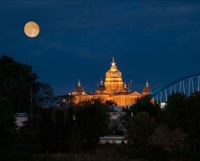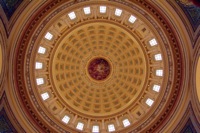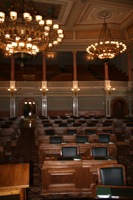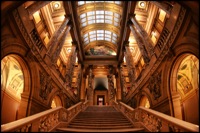 Courtesy Greater Madison CVB
Courtesy Greater Madison CVB
If you want to know the pride of a state, there’s no better place to go for a look than its capitol building.
More than just office complexes and meeting spaces for legislators and government bureaucrats, state capitols are monuments to the history and culture of the people they represent. In their artwork and architecture, these buildings honor pioneers, founders, industrialists and innovators who have made the states what they are today.
Throughout the Midwest, guides at state capitols offer tours for groups, highlighting both characteristic governmental processes and the unique historical and cultural elements of each state. And their locations at the centers of historic districts often make capitol complexes great stops for groups, whose members can then spread out to explore some of the nearby attractions in the capital city after the tour.
On your next trip through the Midwest, be sure to take in the sights at some of these capitols.
Des Moines, Iowa
Completed in 1886 at a cost of $2.8 million, the Iowa state Capitol is a fine example of the period’s architecture and artistic vision.
 |
| Courtesy Des Moines CVB |
“We’re proud that our capitol building is one of the nation’s finest examples of 19th century architecture,” said Greg Edwards, president and CEO of the Des Moines Convention and Visitors Bureau. “It has a 275-foot-tall central dome, covered with a 23-karat gold overlay. It’s considered one of the most beautiful capitol buildings in the United States.”
During a tour of the Capitol, groups will see a number of special touches, from commissioned artwork to custom marble floors and carvings in wood and stone. Visitors should also take some time to explore the 165-acre Capitol grounds, which include a peace officers memorial, a Korean War memorial and a Vietnam War memorial.
After touring the Capitol, many groups also take a tour of the Iowa judicial branch headquarters, a limestone building with a copper-clad dome on the roof adjacent to the Capitol. From there, it’s on to enjoy some free time in the East Village.
“The whole area around the Capitol we refer to as our East Village area,” Edwards said. “There’s a lot of locally owned restaurants and shops. The Iowa Historical Museum is located there, and there are galleries, coffee and tea shops and all sorts of things to do.”
www.seedesmoines.com
Madison, Wis.
Located in the forward-thinking college town of Madison, the Wisconsin state Capitol reflects the city’s individuality.
 |
| Courtesy Greater Madison CVB |
“In the middle, when you look up, there’s this amazing dome that’s a blend of French, Italian and German architecture, murals and frescos,” said Stephanie Sabo, public relations manager for the Greater Madison Convention and Visitors Bureau.
“At the very top of the dome outside is a woman who looks like she’s painted in gold. Locally, we call her Miss Forward, because that’s the Wisconsin state motto. We try to be a national leader and move forward.”
During tours of the building, which was the third capitol on the site when it was completed in 1917, visitors see the rotunda, along with the Governor’s Room, a Rococo-inspired room often used for public meetings and press conferences. At various times throughout the year, the Capitol grounds also host a weekly farmers market and an outdoor concert series.
Just off the grounds is State Street, the heart of the city that is home to numerous restaurants and cultural institutions.
“A couple of steps outside the Capitol square starts the Museum Mile,” Sabo said. “Going from the Capitol downtown toward campus, there are numerous museums with free entry. They range really widely from the Wisconsin Historical Museum to the Veterans Museum to the Chazen Museum of Art.”
Lincoln, Neb.
The Nebraska state Capitol in Lincoln enjoys a number of distinctive characteristics, including an architectural approach that turns the traditional capitol-building concept sideways — literally.
 |
| Courtesy Lincoln CVB |
“Our Capitol is one of four skyscraper state capitols, and it’s been listed by a group of architects as one of the architectural wonders of the world,” said Derek Feyerherm, director of sales at the Lincoln Convention and Visitors Bureau. “It’s a 400-foot tower from top to bottom, approximately 14 stories tall. At the top, you can see Lincoln from all four directions.”
During a tour, groups learn about the state’s unconventional unicameral legislative system and see the chamber where lawmakers meet. The tour also highlights mosaics that depict the history of the state and outdoor sculptures showing the evolution of government over time.
After seeing the Capitol, groups can go across the street to tour the governor’s mansion, which was constructed in the 1950s and recently restored.
“It’s an extraordinary mansion to visit,” Feyerherm said. “It has a doll collection from every Nebraska first lady. There’s a doll depicting each first lady in her inaugural gown.”
Other nearby Lincoln attractions include a Depression-era sunken garden and a rose garden, where 1,300 varieties of roses are cultivated annually.
www.lincoln.org
Topeka, Kan.
It took 37 years to complete construction on the Kansas state Capitol in Topeka, which was built between 1866 and 1903. But the work was worth the wait, as the building today is a masterpiece in beauty and detail.
 |
| Courtesy Topeka CVB |
“They were more worried about the craftsmanship than the time element,” said Andrea Burton, who runs the tour desk at the Capitol. “We had Italian craftsmen over for the marble work and Egyptian plaster workers over for the plaster work. There is a lot of hand-hammered bronze, copper and brass, and all of the wainscoting on the walls is marble.”
When visitors tour the Capitol, their favorite parts are usually the House and Senate chambers, each of which was recently restored to preserve their originally beauty and craftsmanship. The House chamber features ceiling murals from 1882 and 1883 that depict law, justice and the birth of liberty. In the Senate chamber, nearly every inch of the walls is covered with marble or decorative plasterwork, and 22 copper columns that once served to cool the room are now a historical decorative touch.
Many tour groups that visit the Capitol also go across the street to First Presbyterian Church, a historic church with a collection of original Tiffany stained-glass windows. Also nearby is the Brown v. Board of Education National Historic Site, which tells the story of desegregation in America’s public schools.
St. Paul, Minn.
Minnesota’s third and current state Capitol was designed by Cass Gilbert, an influential architect who was only 35 years old at the time, and constructed in 1905. Since then, a number of symbolic artistic touches have been added, including the Progress of State statue.
 |
| Courtesy Visit St. Paul |
“It’s a gold-leafed copper and steel statue, placed on top of the Capitol in 1906,” said Adam Johnson, marketing projects director at the St. Paul Convention and Visitors Association. “It’s a mix of animals, women and men. The four horses represent earth, wind, fire and water. The women represent civilization, and the men represent prosperity.”
The statue is visible from the steps of the Capitol, and on days with good weather, tour guides can take groups up to the balcony that surrounds the statue for an up-close look. The tour also includes visits to the legislative chambers, where guests might see lawmakers at work, as well as the Capitol’s marble rotunda.
A number of nearby attractions also appeal to groups, including the restaurants on Grand Avenue, the Victorian homes on Summit Avenue and one of the city’s most notable churches.
“From the steps of the Capitol, you have a beautiful view of the St. Paul Cathedral,” Johnson said. “There’s a little marker on one of the pews from 1960, when JFK visited the cathedral and sat there. They welcome over 200,000 guests each year.”
More Midwest Travel Guide:
Midwest Capitols: The art of government
Midwest Water: A shore thing
Midwest Presidents: Hail to the chief
WEB EXCLUSIVE! Listing of Midwest Presidential Attractions










